DIY plumbing installation: classic wiring diagrams and installation instructions
Do you want to seriously repair and renovate the apartment? Then it will not be amiss to find out that one of the most basic stages of the overhaul of housing is the replacement of old plumbing and pipes with new ones. In addition, this is the most impressive expense item in the budget allocated for these works.
To reduce the already impressive costs is the normal desire of every prudent owner. Do you agree? It is quite possible to reduce them: do-it-yourself plumbing help. We will tell you how to make wiring, how to transfer and connect plumbing equipment, what tools and materials are needed.
You will learn how to independently change the pipes in the bathroom and connect plumbing fixtures. And in order to make it easier to understand the repair issue, the article provides thematic photo guides and video instructions.
The content of the article:
Project development and drawing
Typical designs of high-rise buildings are not suitable for everyone, and the owners of the apartment try to remake the plumbing according to their preferences. This set of works is very troublesome and time-consuming, however, if you study the theoretical side of the issue well and follow the instructions exactly, most of the work (if not all) can be done independently.
Create detailed piping schemes - An important part of the repair of any, even the smallest bathroom. With the help of the finished project, not even a specialist will be able to evaluate all the advantages and disadvantages of the new location of plumbing fixtures.
A simplified design option will allow you to determine the most suitable way of laying pipes and make a list of the necessary materials in the right quantity, as well as pick up tools.
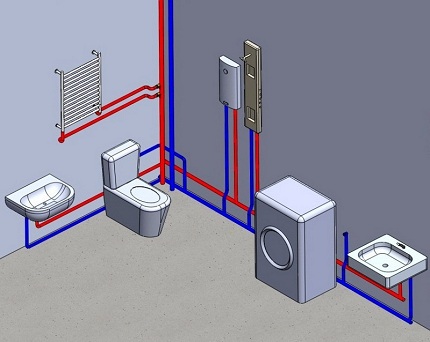
Based on these records, you can calculate the approximate cost of materials, draw up a kind of estimate and purchase everything you need for one or two times.
It is most convenient and easiest to draw up a diagram in several stages. First you need to draw a plan of the bathroom with an indication of the doorway.
In this case, you do not need to measure the size of the room in steps or by eye, with an approximate indication of the location of plumbing fixtures. There is roulette for this. Your comfort when using a plumbing unit depends on how accurately measurements are taken.
Next, indicate in the drawings the location of all plumbing fixtures, taking into account the scale. It is very important to arrange plumbing correctly, you can’t rush here and you need to think everything through well. All devices must be positioned so that there is enough space next to each of them.
For convenience, you can cut out conventional images of devices from a cardboard and move them according to the drawings, choosing the best location.
A detailed development of the communications project and its subsequent implementation is possible under the following conditions:
Which is better: serial or collector circuit?
Today, two commonly used wiring diagrams - sequential and collector.
A sequential (or as it is also called plumbers - tee) system is considered classic. It is used in all typical apartment buildings and private houses with small bathrooms.
The system is very simple - from the central risers, through which hot and cold water is supplied to the apartment, it is laid under one main pipe, from which each plumbing fixture in the apartment is powered.
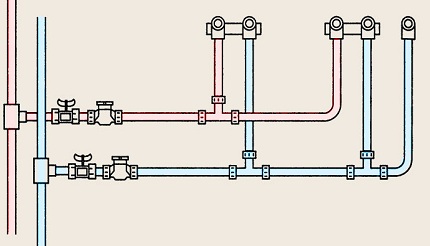
The amount of work on installing plumbing for the bathroom with your own hands is also not very large. However, the benefits of a sequential circuit end there.The main drawback of this type of connection is that all devices are powered by one pipe, and when one device is working, the pressure in all others drops.
That is, when the washing machine pumps water, the pressure in the kitchen faucet will be very weak, and vice versa.
Another drawback is the shutdown method. If one plumbing fixture breaks, then in order to repair it, you will have to completely shut off the water in the apartment. The collector system is used in those houses where there is a large load on the water supply system. In this case, all plumbing points are connected to the collector.
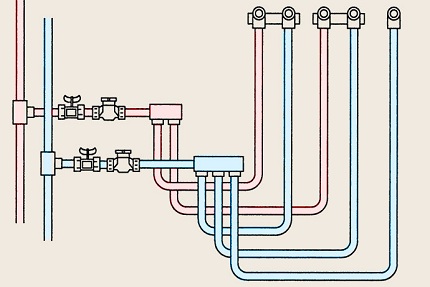
Most often, the collector is hidden in a special cabinet or a closed niche - for aesthetic reasons. Each plumbing fixture is connected to the collector separately, through a personal tap. With this connection method, a large number of pipes will be required, and installation work will take a lot of time.
Although you will have to tinker with connecting such a system, the advantage is obvious: the pressure in all plumbing devices will be stable under any mode of operation of the water supply.
In addition, each device can be turned off or removed if necessary. There is no need to completely shut off the water - just turn off the tap on the right tap.
Bathroom Wiring Device
Herself pipe routing in the bathroom on a large scale does not differ, so you can do without professional calculations to determine the diameters of the pipes. Risers for supplying water are most often made of an inch pipe or a pipe with a diameter of an inch and a quarter. The wiring is usually done with pipes with a diameter of half an inch.
As for the sewer riser, for it you need to take a pipe DN 100, for wiring - DN 50. It must be remembered that the sewer pipe, in a horizontal position, must be laid with a slight slope towards the riser - this is from 5 mm to 3 centimeters per meter length depending on diameter.
Step 1. Choosing a pipeline installation method
The fastest and easiest way to lay is open. In this case, all pipes remain in sight. However, it is not suitable for those people who are serious about the design of the bathroom. In this case, you need to do hidden pipe laying. This method involves laying the pipe in a specially made channel (gate), which is laid in the wall.

Concerning sewer pipe, then it is laid in a special channel, which is then closed and lined with ceramic tiles on top. Of course, with a hidden method of laying, the requirements for the quality of pipes and their joints are greatly increased.
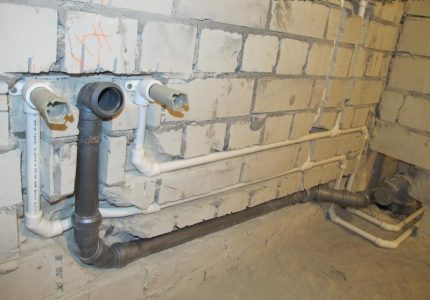
Below we will tell you which pipes can be used for laying inside the walls, and which cannot. When planning to make hidden pipe laying, place the devices in such a way as not to ditch the main walls, since it is forbidden to do this with building codes and rules.
Step # 2. Dismantling old pipes
With modern tools, it is not difficult to dismantle old pipes. If they are hidden in the walls, they need to be opened with a punch. Next, we cut off the pipes with a grinder.
By dismantling the old water pipes before replacing, you must remember safety precautions. For example, a cutting wheel on a grinder can burst from an careless movement with a tool and at high speed fly an unlucky master directly in the face.
Therefore, when working with such a power tool, you need to use special glasses or a transparent visor from plexiglass, and at least a simple cheap respirator to protect against dust.
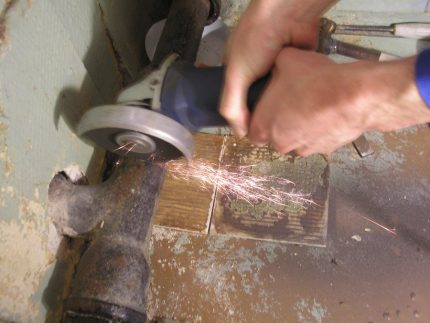
In general, the dismantling of the old pipeline is as follows:
- Completely shut off the water supply.
- Cut or unscrew the root taps, if they need to be changed.
- Install new cranes on the branches of the risers (in this case, it is better to use ball valves).
- Resume water supply.
- If possible, drain the water.
- All plumbing fixtures are disconnected from the water supply and sewage system.
- Pipes unwind or cut.
If the old pipes rest on the dowels, it is enough to cut off the dowel heads so that they do not interfere with the finish. Before cutting off old parts, on new, just installed cranes it is necessary to put on dense plastic bags. Packages are tightly wrapped with lace or tape.
This is necessary to protect the new stop valves from dust and dirt, which will appear in abundance when ditching walls and dismantling old equipment.
Step # 3. Pipe selection
Metal pipe, which until recently was used wherever possible, is rarely used today. This is explained by the shortcomings of the material: the complexity of installation (the need to hire a professional welder), a predisposition to corrosion, the deposition of salts and scale on the inside of the pipes and, as a result, a decrease in throughput.
It should also add a rather considerable cost of a metal pipe.
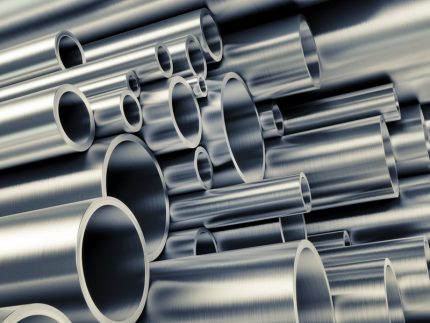
Today for water pipes and do-it-yourself plumbing installation in the bathroom, mainly polymer (plastic) pipes are used. They are devoid of all the shortcomings that are inherent in metal products, and are inferior to them only in strength and melting point, which in this case does not play an important role.
We list the pipes, starting with the cheapest.
Polypropylene (PP). Very lightweight, corrosion resistant material. The surface of the pipe is smooth, due to which low hydraulic resistance is achieved.
Polypropylene pipe is available in two variations:
- PN 10 and PN 16 - are intended only for cold water and are designed for a pressure of 10 and 16 atmospheres, respectively.
- PN 20, PN 25 - used for installation of the heating system, designed to supply hot water, designed for a pressure of 20 and 25 atmospheres.
These grades have a special reinforcement of aluminum or fiberglass to prevent expansion under the influence of temperature. The main feature of the polypropylene pipe is thick walls, respectively, large connecting fittings. But all the parts are pretty cheap and very easy to install.
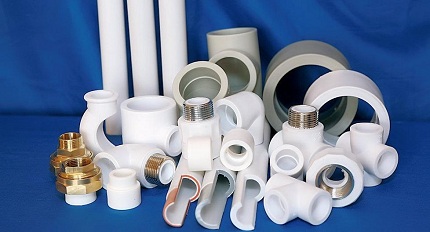
Polyethylene pipe. It has several variations:
- HDPE (made of low pressure polyethylene);
- PEX-A, PEX-B, PEX-S - cross-linked polyethylene (all of the above grades are made in different ways);
- PE-RT - polyethylene having a molecular seal.
Most often, a polyethylene pipe is used for external wiring.
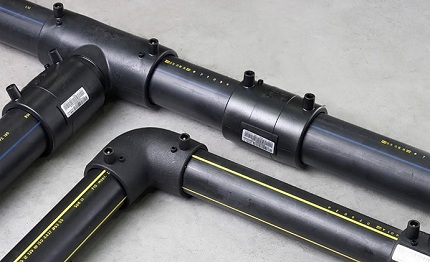
Plastic pipe. The walls of this pipe consist of different materials, as the name implies - from several layers of polyethylene and an aluminum layer. Plastic pipe and fittings are more expensive than polypropylene and polyethylene. However, they are considered more durable, and at the same time have a modest size. The pipe itself bends very well and holds its shape.
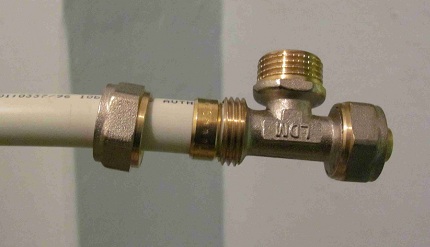
A little higher we mentioned the hidden pipe routing. Only polypropylene pipes are suitable for this method, since when installing the plumbing with their own hands, they are welded into a monolithic structure, and the possibility of leakage is practically excluded here.
Step # 4. Installation of polypropylene wiring
Main advantage PP pipes lies in their strong connection. For this, a special soldering iron is used, which heats the ends of the pipes almost to the melting temperature. After warming up, the parts are pressed tightly against each other, after which they are joined tightly - a monolithic structure is obtained.
In order to make a connector or a transition to a metal pipe, use a special fitting with metal thread inside. A pipe soldering iron is a fairly simple and inexpensive device that can be bought at any specialized store. As a rule, nozzles for pipes of different diameters are sold with a soldering iron.
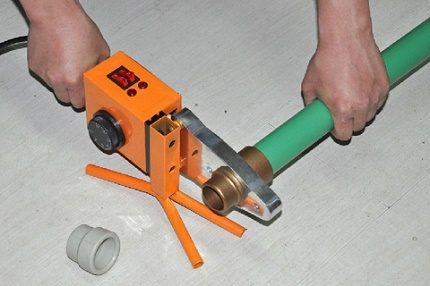
The popular name is “irons” equipment for soldering PP pipes received due to external resemblance to a traditional household appliance for ironing. For cutting polypropylene pipes, special scissors are needed, otherwise the cut will be uneven and inaccurate.

If the polypropylene pipe has reinforcement made of aluminum foil, the cut must be cleaned with a special tool - a scraper. If not, buy a pipe with fiberglass reinforcement. A slice of such a pipe does not need to be cleaned. The same can be done if you buy a pipe from an unknown manufacturer.
The fact is that fiberglass reinforcement is inexpensive, so the probability of buying defective goods is much lower.
When laying a hidden wiring, a special insulation made of foamed polyethylene must be put on the polypropylene pipe. In this way, you will have the space needed to expand the polypropylene under the influence of temperature.
The following photo gallery will familiarize with the sequence of assembly and installation of the water supply system:
The assembly of the pipeline from polypropylene pipes has its own tricks, which should be closely monitored:
How to connect a regular sink?
First you need to calculate the height sink installation. In most cases, it is no more than 80 cm. However, if the house has small children, the washbasin can be lowered a little. After the height is determined, put a mark on the wall.
Focusing on it, we mark a horizontal line on the surface of the wall. After that, you need to measure the width of the back wall of the washbasin and put this distance down from the mark.

Before attaching the brackets to the wall, you need to accurately calculate the distance between them. It is not difficult to do this: we turn the washbasin over, put the brackets on top so that they fall into special grooves. Next, measure the distance between the brackets and transfer it to the wall.
Now you can make holes, beat dowels, tighten the bolts. Next, you need to install a mixer on the sink, then fasten it with bolts and washers, check the location of the sink by level and fix it with nuts.
We install a rubber gasket on the drain hole and mount the drain, connect it to the siphon. Using the adapter, we connect the drain pipe of the siphon to the sewer. Using flexible hose-tips, we connect hot and cold water to the mixer.
How to install a sink on a pedestal?
In this case, it is very important to make the markup correctly. We put a pedestal, on top we install a sink in such a way that the drain is exactly in the center of the stand. We check its location using the building level.
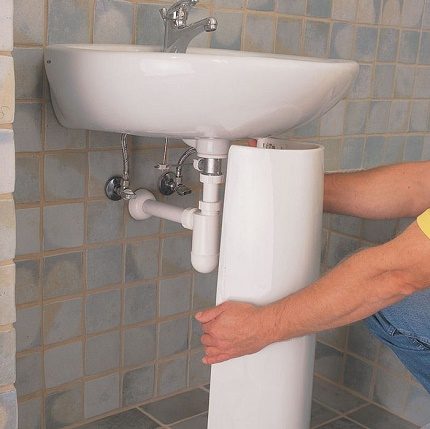
After that, carefully mark the places of fastenings for the bowl on the adjacent wall. The entire structure can be temporarily disassembled to make holes in the wall. After this we beat the dowels, twist the screws, put on the gasket nuts.
Now it remains to fasten the washbasin to the wall. The main thing here is not to overdo it, since ceramics can crack if you tighten the nuts too much. Inside the pedestal, you need to install a siphon and connect it to the wash basin, and the drain pipe to the sewer.
In order to visualize the installation process of the sink with a pedestal, we suggest that you familiarize yourself with the following selection of photos:
Toilet Installation Recommendations
The most popular toilet model is the floor. If the bathroom floor is faced with ceramic tiles, you need to put something soft under the toilet - for example, a piece of linoleum or rubber. To connect toilet to the sewerage, you need to use a special cuff. One end is connected to the toilet, and the other to the sewer pipe.
The toilet is attached to the floor with special studs that are inserted into dowels fixed in pre-made holes.
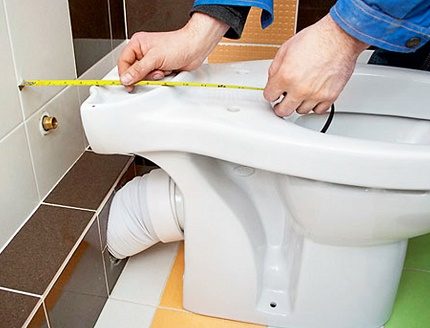
In some cases, the toilet sticks to the floor with epoxy glue. In this case, the toilet should not be used for approximately 12 hours until the glue completely hardens.
Conclusions and useful video on the topic
You can find tips on wiring devices and self-installation of plumbing equipment in the following videos.
Video # 1. How to make wiring from PP pipes:
Video # 2. Useful tips for welding PP pipes and installing plumbing:
As part of this publication, we provided only general information on the replacement of plumbing and pipe wiring - this topic is too extensive to be fully disclosed in one article. However, we hope that this material will help you in planning and carrying out repairs in the bathroom, choosing materials and replacing plumbing fixtures.
Please write comments in the block below. We are interested in your stories about personal experience in self-installation of plumbing fixtures. We are waiting for messages with useful facts and questions on interesting points.

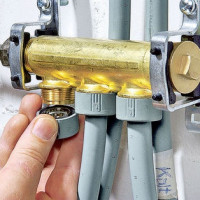 Water distribution in the apartment: typical schemes + design nuances
Water distribution in the apartment: typical schemes + design nuances  The layout of the water supply pipes in the apartment: common schemes and options for implementation
The layout of the water supply pipes in the apartment: common schemes and options for implementation 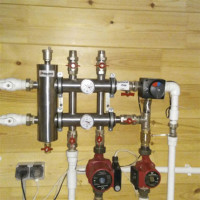 Hydroarrow for heating: purpose + installation diagram + parameter calculations
Hydroarrow for heating: purpose + installation diagram + parameter calculations  How much does it cost to connect gas to a private house: the price of organizing gas supply
How much does it cost to connect gas to a private house: the price of organizing gas supply  The best washing machines with dryer: model rating and customer tips
The best washing machines with dryer: model rating and customer tips  What is the color temperature of light and the nuances of choosing the temperature of the lamps to suit your needs
What is the color temperature of light and the nuances of choosing the temperature of the lamps to suit your needs  Replacement of a geyser in an apartment: replacement paperwork + basic norms and requirements
Replacement of a geyser in an apartment: replacement paperwork + basic norms and requirements
I also installed the heating system myself. The wiring is essentially very similar to water supply. I want to separately note the moment with the choice of pipes.All mainly choose metal-plastic. They are more resistant to high and unstable temperatures, but at the same time much more expensive than polypropylene. If the financial issue is urgent and I want to keep the temperature at the level of 90-100 degrees, I can advise reinforced polypropylene: it will surprise at a price and will not bend from heating.
Now only I will put the plumbing in the bathroom! Already once trusted “professionals” - so they managed to install a wash basin WITHOUT a siphon, with an ordinary corrugated pipe! They were motivated by the fact that “your machine will not get under the sink otherwise”. A month later, the corrugated pipe was completely clogged, I had to remove the washing machine and redo everything. It is better to study the issue and, if the hands are from the right place, do everything yourself, than run into this.